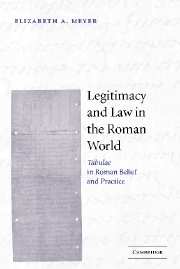Book contents
- Frontmatter
- Contents
- List of illustrations
- Acknowledgments
- List of abbreviations
- Introduction
- Part One THE WORLD OF BELIEF
- Part Two THE EVOLUTION OF PRACTICE
- Chapter 6 Roman tablets in Italy (AD 15–79)
- Chapter 7 Roman tablets and related forms in the Roman provinces (30 BC–AD 260)
- Chapter 8 Tablets and other documents in court to AD 400
- Chapter 9 Documents, jurists, the emperor, and the law (AD 200–AD 535)
- Conclusion
- References
- Index
Chapter 6 - Roman tablets in Italy (AD 15–79)
Published online by Cambridge University Press: 22 September 2009
- Frontmatter
- Contents
- List of illustrations
- Acknowledgments
- List of abbreviations
- Introduction
- Part One THE WORLD OF BELIEF
- Part Two THE EVOLUTION OF PRACTICE
- Chapter 6 Roman tablets in Italy (AD 15–79)
- Chapter 7 Roman tablets and related forms in the Roman provinces (30 BC–AD 260)
- Chapter 8 Tablets and other documents in court to AD 400
- Chapter 9 Documents, jurists, the emperor, and the law (AD 200–AD 535)
- Conclusion
- References
- Index
Summary
As a result of the eruption of Vesuvius, over four hundred legal and financial tabulae dating between AD 15 and AD 79 have been preserved in the Campanian region of Italy. Over these sixty-four years, several important changes in both the physical form and the internal formulation of these tablets can be observed, changes that are part of the larger transformation of the tabula from the authoritative embodiment of a ceremonial act into the embodiment of an act that drew its authority not only from the process of its making but also from the people who made it. These changes fall along three interrelated trajectories. First, there was a change in physical form, from diptych to triptych, that occurred at a different time and a different rate for documents of different types of act, reflecting not only the traditional linkage of type of legal act, style of writing, and physical form but also the conservative qualities of tabulae distantly or closely associated with ceremonial, unitary acts. Second, as physical forms changed so too did at least some of the acts themselves, the traditional association of act and form reinforced by the way change in both form and content took place: as a third tablet was hinged to the original two, so too were different acts added to but not coalesced with the original one, creating a multi-part combinational act on a triptych.
- Type
- Chapter
- Information
- Legitimacy and Law in the Roman WorldTabulae in Roman Belief and Practice, pp. 125 - 168Publisher: Cambridge University PressPrint publication year: 2004

